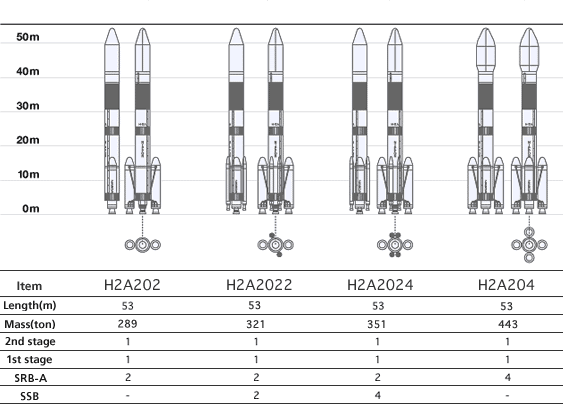Featured Image: JAXA/Mitsubishi Heavy Industries
Lift Off Time | September 6, 2023 – 23:42 UTC September 7, 2023 – 08:42 JST |
|---|---|
Mission Name | XRISM/SLIM |
Launch Provider | Japan Aerospace Exploration Agency (JAXA) |
Customer | JAXA |
Rocket | H-IIA 202 |
Launch Location | LA-Y1, Tanegashima Space Center, Japan |
Payload mass | Unknown, but probably no more than ~4,000 kg (~9000 pounds) |
Where did the satellites go? | XRISM will operate in Low-Earth Orbit and SLIM will land on the moon |
Did they attempt to recover the first stage? | No, this is not a capability of the H-IIA |
Where did the first stage land? | It crashed into the ocean |
Did they attempt to recover the fairings? | No, this is not a capability of the H-IIA |
Were fairings new? | Yes |
This was the: | – 143rd orbital launch attempt of 2023 – 47th H-IIA mission – 2nd H-IIA mission of 2023 – 1st JAXA mission of 2023 |
Where to watch | Official replay |
How Did It Go?
JAXA successfully launched two satellites, XRISM and SLIM, atop a H-IIA 202 rocket. The rocket launched 10 days later than originally planned due to bad weather. XRISM will operate in low-Earth orbit, while SLIM will travel to and land on the moon! The rocket took off from the Tanegashima Space Center in Japan. This mission marks the second launch of a H-IIA 202 in 2023.
XRISM
The X-Ray Imaging and Spectroscopy Mission (XRISM), is a JAXA X-ray astronomy satellite which will study structure and formation of the universe, outflows from galaxy nuclei, and dark matter. XRISM will function as a next-generation space telescope in the X-ray astronomy field, following on from JAXA’s previous astronomy satellite Hitomi which was lost prematurely.
SLIM
The Smart Lander for Investigating the Moon (SLIM) is Japan’s first lunar surface mission. The lander will demonstrate it’s ability to precisely land on the surface. H-IIA will place this spacecraft into a trans-lunar injection, then, once the lander reaches the moon, SLIM will explore the lunar surface near the Marius Hills Hole, which is a possible entrance to a lava tube.
What Is The H-IIA 202?
H-IIA 202 is a two-stage liquid-fuel medium-lift launch vehicle operated by Mitsubishi Heavy Industries for JAXA. It is about 53 m (174 ft) in height and 4.0 m (13 ft) in diameter and is capable of placing a 4,000 kg payload into Geostationary Transfer Orbit (GTO). Its maiden flight took place on August 29, 2001. Since then, it has launched 43 times, with just one failure that occurred on November 29, 2003. The H-IIA rocket has several variants, with only H-IIA 202 and H-IIA 204 currently being active.

H-IIA rockets have a three to four number configuration code following the prefix “H2A”. The first number represents the number of stages. The second number denotes the number of liquid rocket boosters (LRBs). Finally, the third number shows the number of solid rocket boosters (SRBs). For this launch, the H-IIA 202 rocket will have two stages, no LRBs, and two SRBs.
| First Stage | Solid Rocket Booster | Second Stage | |
| Engine | LE-7A | SRB-A | LE-5B |
| Propellant | LH2/LOx | HTPB Composite | LH2/LOx |
| Propellant Mass, kg | 100,000 | 65,000 each | 16,600 |
| Thrust, kN (lbf), vacuum | 1,098 (246,840) | 2,520 (566,519) each | 137 (30,799) |
| Specific Impulse (ISP), s, vacuum | 440 | 283 | 448 |
| Burning Time, s | 390 | 100 | – |

First Stage
All stages of H-IIA rocket are expendable. Its first stage is powered by a LE-7A engine and is capable of producing 1,098 kN of thrust, with an ISP of 440 s. The propulsion system runs on liquid hydrogen (LH2) and liquid oxygen (LOx). Apart from the engine section, this stage consists of fuel tanks, a center section connecting them, and an interstage.
SRB-A
A pair of SRB-As on the H-IIA 202 rocket fire for approximately 100 s from liftoff. Each one of them is capable of producing 2,520 kN of thrust, with an ISP of 283 s, which augments total thrust of the rocket.
Second Stage
A second stage is powered by an LE-5B engine that also runs on LH2 and LOx and can be ignited up to three times. This stage is capable of producing 137 kN of thrust, with an ISP of 448 s. The avionics system can be found on the equipment panel of this stage. The hydrazine-jet reaction control system is mounted under the avionics equipment panel and is used for attitude control.
In addition, a long-coast variation of this stage is available for geostationary orbit missions. It features several modifications that allow enhancing the mission time and suppressing the propellant loss during long-coast.
Payload fairings
Three types of payload fairings (4S, 5S, and 4/4D-LC) are available for H-IIA rockets. The first two of them can be used for a dedicated launch, whereas the 4/4D-LC model can be used for a dual launch.




